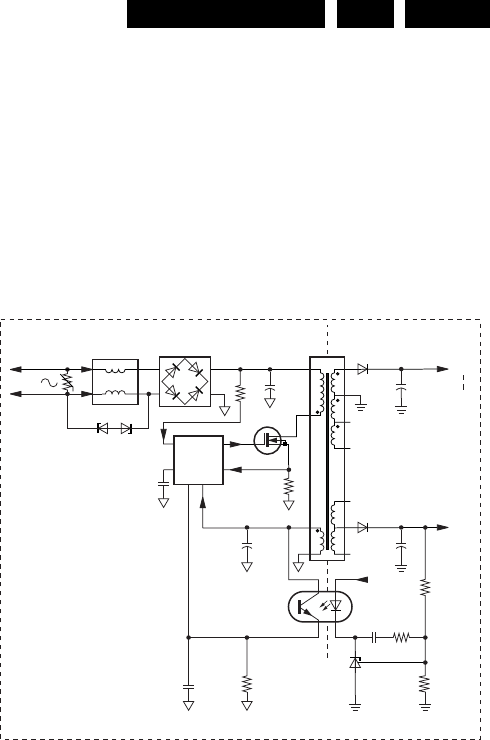
Alignments
EN 67DVD763SA 8.
8. Alignments
Not applicable.
9. Circuit Descriptions and List of Abbreviations
Index of this chapter:
1. Introduction
2. Power Supply Unit (PSU).
3. Loader/Mono Board.
4. Audio Video (A/V) Board.
5. Front Display Board.
6. Abbreviations
7. IC Data
Notes:
• See also the SD4.0 SA_CH Service Manual (3122 785
12480).
• Figures can deviate slightly from the actual situation, due
to different set executions.
• For a good understanding of the following circuit
descriptions, please use the diagrams in chapter 6 and 7.
Where necessary, you will find a separate drawing for
clarification.
9.1 Introduction
The DVD763SA is a model from the SACD 2002 'single disc'
range. It uses a 2nd generation Philips SACD mono board,
based on the Furore 2 DSD/DST decoder.
Below you will find a circuit description of the several modules.
9.2 Power Supply Unit
9.2.1 Introduction
This supply is a Switching Mode Power Supply (SMPS), which
uses the control IC TY720xx to produce pulses to drive the
power ‘switch’ (MOSFET). The TY720xx (IC7130) is a high
performance, current mode controller for DC-to-DC converter
applications.
The operation frequency varies with the circuit load. When the
output power demand decreases, the switching frequency
raises, with a maximum frequency of 125 kHz (defined by
C2130 at pin 5). At this point, the internal VCO takes over and
starts to decrease the switching frequency.
This has some benefits compared to a ‘fixed frequency’ flyback
converter. The efficiency is better, which results in a lower
power consumption.
9.2.2 Output Voltages
The following output voltages are present on connector 0201:
• Pin 1 and 2: +3V3_POWER.
• Pin 4: +12V_POWER
• Pin 5: +12STBY.
• Pin 7: +5VSTBY.
• Pin 9: -12V_POWER.
• Pin 11: -32V_POWER.
Note: The suffix 'STBY' indicates that the supply is not
switched 'off' during Standby Mode. Power switching is done
with the STBY_CTRL signal from the slave processor.
9.2.3 Operation
Figure 9-1 Power Supply
Mains Input Circuit
The bridge rectifier D6110 rectifies the mains voltage, after
which C5 (2117) smoothens it. The DC voltage across this
capacitor is the DC input voltage (approximately 300V), to pin
1 of transformer T1 (pin 9 of 5190) and pin 1 of IC1 (7130).
The mains input also consists of a (differential mode) lightning
protection DM1 (R3110) and a (common mode) lightning
protection CM1 (D6114/15).
Start-up Circuitry
The rectified voltage from the bridge rectifier is connected to
pin 1 of IC1. This voltage will charge the Vcc capacitor C7
(C2131). When this voltage, (at pin 13), reaches the start-up
threshold of min. 15V, the control circuit starts to operate.
After start-up, the control IC requires a sinking current, which
the start-up circuitry cannot deliver. Therefore a take-over
circuitry (a coupled winding of transformer T1) is present. The
voltage at this point will take over the supply voltage at pin 13
of the IC1(7130).
If the take-over circuit does not function, IC1 (7130) will switch
'off' again at the minimal operating voltage of +8V. The whole
operation cycle will repeat itself with audible hiccup sound if
take-over is not present.
Secondary Voltage Sensing
The secondary voltage regulating circuit comprises of opto-
coupler IC2 (7190), which isolates the error signal from the
control IC on the primary side, and a reference component IC3
(7290, TL431).
CL 26532053_024.eps
010502
D
G
S
115
1
DM1
13
12
AC
DC
+12V
+12V
C7
IC1
CM1
IC3
RECTIFIER
EMI-FILTER
MAINS
R
SENSE1
R
SENSE2
Q1
300V
IC2
T1
etc
C5
4
